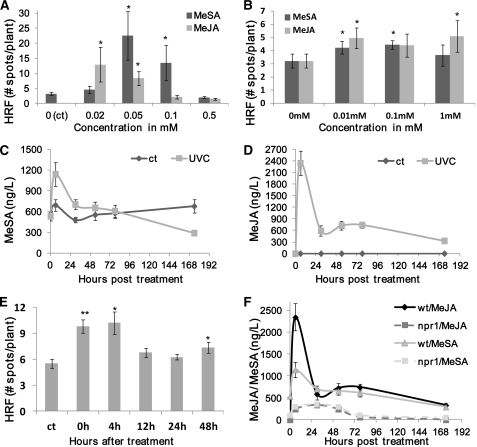Figure 2.
Role of MeSA and MeJA in Eliciting an Increase in HRF.
(A) HRF in wild-type plants after direct spraying with MeSA or MeJA. Three-week-old Arabidopsis plants were sprayed with MeSA or MeJA at various concentrations, ranging from 0.02 to 0.5 mM. Bars show average HRF ± sd of three biological repeats, each one consisting of three pots containing 12 to 20 plants . Asterisks indicate significant difference compared with control mock-sprayed Arabidopsis (P < 0.05).
(B) HRF in wild-type Arabidopsis plants after being exposed to a MeSA- or MeJA-enriched environment. Each experimental point consisted of three pots with 12 to 20 plants in each one. Bars represent average HRF ± sd. Asterisks indicate significant difference compared with control (0 mM) unexposed Arabidopsis (P < 0.05).
(C) MeSA levels (ng/L) in the headspace of UV-C–irradiated plants. After irradiation with 7.0 J/m2 UV-C, gas samples were taken and MeSA concentration was determined. The data are the average ± sd of four biological repeats.
(D) MeJA levels (ng/L) in the headspace of UV-C–irradiated plants. Experimental details are the same as in (C).
(E) Time course of volatile production after UV-C irradiation. Bars represent average bystander HRF ± sd of three biological repeats, each one consisting of three pots containing 12 to 20 plants. Asterisks indicate significant difference compared with control mock-sprayed Arabidopsis (P < 0.05). Asterisks indicate a significant difference from control (*P < 0.05 and **P < 0.01).
(F) MeSA and MeJA levels (in ng/L) in the headspace of UV-C–irradiated wild-type and npr1 plants. Experimental details are the same as in (C).

